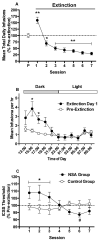A lack of association between severity of nicotine withdrawal and individual differences in compensatory nicotine self-administration in rats
- PMID: 21494791
- PMCID: PMC3601679
- DOI: 10.1007/s00213-011-2273-9
A lack of association between severity of nicotine withdrawal and individual differences in compensatory nicotine self-administration in rats
Abstract
Rationale: Compensatory smoking may represent an adverse consequence of smoking reduction or the use of reduced-nicotine tobacco products. Factors contributing to individual variability in compensation are poorly understood.
Objective: The objective of this study was to examine whether severity of nicotine withdrawal as measured by elevated intracranial self-stimulation (ICSS) thresholds is related to individual differences in compensatory nicotine self-administration (NSA) following unit dose reduction.
Methods: Rats were trained for ICSS and NSA (0.06 mg/kg per infusion). After stabilization, effects of reducing the nicotine unit dose to 0.03 mg/kg per infusion were examined. Following reacquisition of NSA (0.06 mg/kg per infusion), effects of antagonist-precipitated withdrawal and saline extinction (spontaneous withdrawal) were examined.
Results: Reducing the NSA unit dose produced partial compensation as indicated by the increased infusion rates, but a 35% mean decrease in daily nicotine intake. The magnitude of compensation varied considerably among rats. Dose reduction did not elicit withdrawal in rats as a group, although there were substantial increases in ICSS thresholds in some animals. Intracranial self-stimulation thresholds were consistently elevated during precipitated and spontaneous withdrawal, confirming that rats were nicotine-dependent. Individual differences in compensation were not correlated with changes in ICSS thresholds during dose reduction, precipitated withdrawal, or spontaneous withdrawal. In a secondary analysis, greater precipitated withdrawal severity predicted greater initial nicotine seeking during extinction.
Conclusions: Severity of nicotine withdrawal was not related to the degree of compensation in this protocol. These data do not support a role for nicotine withdrawal in individual differences in compensation during reduced nicotine exposure, but do suggest that withdrawal may contribute to nicotine seeking during early abstinence.
Figures






Similar articles
-
Correlates of individual differences in compensatory nicotine self-administration in rats following a decrease in nicotine unit dose.Psychopharmacology (Berl). 2009 Sep;205(4):599-611. doi: 10.1007/s00213-009-1567-7. Epub 2009 May 28. Psychopharmacology (Berl). 2009. PMID: 19475400 Free PMC article.
-
Prevalence, magnitude, and correlates of an extinction burst in drug-seeking behavior in rats trained to self-administer nicotine during unlimited access (23 h/day) sessions.Psychopharmacology (Berl). 2007 Oct;194(3):395-402. doi: 10.1007/s00213-007-0848-2. Epub 2007 Jul 5. Psychopharmacology (Berl). 2007. PMID: 17611741
-
Similar precipitated withdrawal effects on intracranial self-stimulation during chronic infusion of an e-cigarette liquid or nicotine alone.Pharmacol Biochem Behav. 2017 Oct;161:1-5. doi: 10.1016/j.pbb.2017.08.011. Epub 2017 Sep 1. Pharmacol Biochem Behav. 2017. PMID: 28867606 Free PMC article.
-
Effects of repeated withdrawal episodes, nicotine dose, and duration of nicotine exposure on the severity and duration of nicotine withdrawal in rats.Psychopharmacology (Berl). 2003 Jul;168(3):280-92. doi: 10.1007/s00213-003-1414-1. Epub 2003 Apr 24. Psychopharmacology (Berl). 2003. PMID: 12712232
-
Compensatory nicotine self-administration in rats during reduced access to nicotine: an animal model of smoking reduction.Exp Clin Psychopharmacol. 2008 Feb;16(1):86-97. doi: 10.1037/1064-1297.16.1.86. Exp Clin Psychopharmacol. 2008. PMID: 18266555
Cited by
-
Nicotine reduction: strategic research plan.Nicotine Tob Res. 2013 Jun;15(6):1003-13. doi: 10.1093/ntr/nts214. Epub 2012 Oct 25. Nicotine Tob Res. 2013. PMID: 23100460 Free PMC article. Review.
-
Animal models of nicotine exposure: relevance to second-hand smoking, electronic cigarette use, and compulsive smoking.Front Psychiatry. 2013 Jun 4;4:41. doi: 10.3389/fpsyt.2013.00041. eCollection 2013. Front Psychiatry. 2013. PMID: 23761766 Free PMC article.
-
Tobacco smoke exposure enhances reward sensitivity in male and female rats.Psychopharmacology (Berl). 2021 Mar;238(3):845-855. doi: 10.1007/s00213-020-05736-0. Epub 2021 Jan 7. Psychopharmacology (Berl). 2021. PMID: 33410984 Free PMC article.
-
The dark side of emotion: the addiction perspective.Eur J Pharmacol. 2015 Apr 15;753:73-87. doi: 10.1016/j.ejphar.2014.11.044. Epub 2015 Jan 9. Eur J Pharmacol. 2015. PMID: 25583178 Free PMC article. Review.
-
Impact of tobacco regulation on animal research: new perspectives and opportunities.Nicotine Tob Res. 2012 Nov;14(11):1319-38. doi: 10.1093/ntr/nts162. Epub 2012 Sep 4. Nicotine Tob Res. 2012. PMID: 22949581 Free PMC article. Review.
References
-
- Ahmed SH, Kenny PJ, Koob GF, Markou A. Neurobiological evidence for hedonic allostasis associated with escalating cocaine use. Nat Neurosci. 2002;5:625–6. - PubMed
-
- Benowitz NL. Pharmacology of nicotine: addiction and therapeutics. Annu Rev Pharmacol Toxicol. 1996;36:597–613. - PubMed
-
- Benowitz NL. Clinical pharmacology of nicotine: implications for understanding, preventing, and treating tobacco addiction. Clin Pharmacol Ther. 2008;83:531–41. - PubMed
-
- Benowitz NL, Hall SM, Stewart S, Wilson M, Dempsey D, Jacob P., 3rd Nicotine and carcinogen exposure with smoking of progressively reduced nicotine content cigarette. Cancer Epidemiol Biomarkers Prev. 2007;16:2479–85. - PubMed
Publication types
MeSH terms
Substances
Grants and funding
LinkOut - more resources
Full Text Sources

